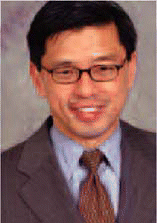Swallowing Interventions
At the University of Pennsylvania Center for Voice and Swallowing, pretreatment counseling sessions with a speech-language pathologist introduce patients to potential side effects of chemoradiation-increasingly the treatment of choice over surgery for these cancers. According to Patricia K. Dooley, MS, CCC, SLP, Interim Director of the Speech-Language Pathology Department, these pretreatment counseling sessions provide an overview of the causes of dysphagia associated with these treatments, as well as the potential signs and symptoms of dysphagia. Patients are also presented with a range of oropharyngeal exercises, which target the tongue, lips, palate, and larynx and are designed to preserve swallowing function. The exercises, explained Dr. Mirza, can diminish the changes of severe fibrosis setting in due to radiation. The object is to help the patient continue to use muscles in the pharynx, thus preventing atrophy, even if he or she is using a feeding tube. With each passing day that they are not using those muscles, it gets less and less likely that they will ever use those muscles again, she noted.
The speech-language pathologists also re-evaluate their patients midway through treatment, when potential side effects of radiation begin to occur. Mucositis, xerostomia, trismus, and edema of the swallowing structures can start to affect patients’ swallowing. During this evaluation, patients will be trained in specific postural and swallowing maneuvers, and given food texture recommendations. The goal is to keep patients swallowing safely throughout the course of their treatment. Even if use of a tube becomes necessary for nutritional purposes, patients are encouraged to continue with their exercises. Our ultimate goal, said Ms. Dooley, is to have these patients resume a functional, oral diet.
Combating Isolation, Depression
Even if they are cancer-free after treatment, patients with oral, head and neck cancer fall into significant isolation that comes from not being able to eat by mouth, said Dr. Mirza, because all social activities in almost every society are based around eating. When an individual cannot eat, there is no reason to sit at the table or to sit with your friends or family. That leads to tremendous isolation and depression, and we know that depression can lead to increased morbidity, and poorer outcomes. (See sidebar.)
Helping the Patient
Referring ENTs can help ease the planning, treatment, and follow-up process by attending to a few important details, said Dr. Yao. For instance, he appreciates personal telephone communication from the referring physician. Otolaryngologists in the community can reinforce that patients traveling to a larger cancer center should be certain to obtain complete records. It’s very helpful to have all the actual X-rays, the actual pathology slides, and not just the readings from those, he said. Following treatment, the referring physician can help patients who prefer not to travel back to the cancer center for follow-ups. Typical follow-up intervals are every four to six weeks for the first year, every two months for the second year, and every three months for the third year. That’s a lot of driving, he noted, especially for someone who’s just been through chemotherapy and radiation.


Leave a Reply